Last night we were forced to “sleep rough” in Modestine on the streets of La Línea. Our leisure battery proved to be incapable of running our laptop, despite being assured that it could before we left England. So we were unable to write our blog last night. This is therefore two days in one.
Yesterday at the campsite just outside of Ronda we woke to the patter of rain to discover the surrounding mountains had disappeared and we were shrouded on mist. According to our guidebook, this area is reputed to be the wettest in Spain and we are willing to believe it.
We abandoned our plans to drive across the mountains to Arcos de la Frontera, which is marked by Monsieur Michelin as a beautiful route on his map, taking in several of the pueblos blancos on the way. Instead, we decided to make our way down towards La Línea, following in Modestine, much the same route as we took a couple of years ago when we backpacked around this area by bus and train.
Despite the rain and the swirling mist, the route along near deserted, twisting roads through snow clad mountainsides was stunning, the low level clouds being very atmospheric. At the isolated whitewashed village of Atajate we parked Modestine beside the village lavoir, where the mountain stream is used for washing clothes, and set off to explore. The village staggered up the hillside, a network of tiny alleyways too narrow for transport. This was a complete contrast to the brash resorts along the coast. We passed a lady, probably much the same age as us, wearing a nylon overall, thick stockings and wellies clutching a pumpkin under her arm. She wished us buenos dias. It really is another world.
 Atajate
AtajateWe continued to Benalalid, another white mountain village but this time with a little square lined with orange trees, a fountain, several sleepy dogs and a tiny supermercado! Here the lady was very sweet and helpful selling us some delicious local biscuits baked in Jimena de la Frontera, a hilltop town we passed a little later.
 Benalalid with its orange trees
Benalalid with its orange treesBeyond this village the roads were in a terrible state being resurfaced every few kilometres, so much of our time was spent being waved through, or halted, by cheerful Spaniards, each with a red/green stick, even though we were frequently the only people using the road! Here we splished and sploshed our way through endless potholes along unmetalled roads as the rain poured down and the clouds and mist swirled around us, lending an air of gothic mystery to the landscape and, probably mercifully, hiding many of the sheer drops beside the twisting road from view.
It was a really strange feeling, in this high, wet, deserted landscape, to suddenly cross a tiny bridge over a single-track railway line, to recall that little more than a year ago, we had travelled that line on an equally wet day on the mountain train from Ronda to Algeciras. (We have an account of this which we will eventually link to this blog.)
Gradually the landscape changed as we descended from the Sierra. It became greener and horses and cattle started to appear in the fields. Our route became lined with eucalyptus trees. We passed Jimena de la Frontera, a white town spread out on the green hillside. We tried to visit but the rain was such that the access route was completely flooded and we ended up in a muddy cobbled road blocked by building work.
Next we entered the Parque Natural de los Alcornocales famed as having the largest cork oak forest in Spain. Our endeavours to photograph some of the trees were frustrated by the Spanish traffic police. In torrential rains, high in the deserted hills, we stopped by the roadside for Ian to take a picture showing how the lower truck has its bark removed and is then left to recover until it has re-grown. There is nowhere at all to stop on Spanish mountain roads. You can drive for hours searching for somewhere to pull off the road but invariably there is either a sheer drop or an enormous drainage dip beside the tarmaced road. So we illegally stopped on our deserted mountain road for a photoshot. Within a second there was the sound of a siren and the Spanish traffic police roared up behind us with their lights flashing! We had no option but to drive on immediately, to be followed right down to the next village by an angry police car, where we pulled in to let it pass!
 Cork oaks through the rain with bark removed
Cork oaks through the rain with bark removedWe had hoped the weather would be better down at the coast but it became steadily worse as we descended below the clouds. Deciding there was nothing we could do in such a downpour except eat, we pulled into a wayside posada at Almoraima around 3.30pm for lunch. This is quite normal in Spain and the place was packed. We found a small table squashed in between other, larger ones crammed with Spanish men and just a few women. It was obviously where the three hour siesta is spent before returning to work until late into the evening. (They have very different hours in Spain from the rest of Europe.) Ignoring the menu we were handed we asked for the menu of the day, as being eaten by everyone else. This turned out to be amazing. For two of us beer, bottled water, bread, mixed salad, beef and sausage stew, followed for each of us by pork slices in pepper sauce with chips, crème caramel with cream and chocolate sauce and a couple of coffees cost us the grand total of 16 euros (about £11.20) Into the bargain we experienced a real noisy Spanish atmosphere and coped entirely in Spanish!
Outside the rain was falling as relentlessly as ever as we descended to San Roque where we recognised the station where we disembarked last time, only to discover we were miles from our destination. Then we had taken a taxi down to La Línea. This time we drove the same road and we were surprised to find it so very familiar. It’s amazing how much the mind can take in and file away until it’s needed again!
As we approached the coast and the town of La Línea the rain became so heavy we decided it was unsafe to drive so pulled into a parking area near a supermarket to wait. Here, with great amusement we listened to Gibraltar radio. How can those poor presenters find something interesting to say about the rock day, in day out? We heard all about the traffic chaos in Cornwall Place due to road works until March and were delighted to receive a really localised weather forecast. It was raining on the rock! Ha ha! Through Modestine’s window all we could see through the driving rain was the dim outline of Gibraltar looming huge against a leaden sky. We knew it was raining, as did everyone else listening to the programme! Good news though, it would improve and tomorrow would be sunny!
So we braved the rain and drove into the Spanish frontier town of La Línea and crawled around in the rain, searching out the tourist office. Yes, there was a campsite open! However, our relief was short-lived. When we eventually located it we found it completely waterlogged and under several feet of water in places. Impossible even to drive Modestine onto the site! So we sought out the cheap hotel we’d used when back-packing. Here a drunk was singing loudly outside and it seemed even seedier than when we last used it. We were worried about abandoning Modestine in a town with a possibly dubious reputation for the night. Eventually we decided the best solution was to sleep on the street near the seafront sports stadium, beneath the looming shadow of the rock of Gibraltar, in the hope that no harm would befall her.
 Gibraltar seen from Modestine’s overnight parking place
Gibraltar seen from Modestine’s overnight parking placeOutside the moon shone over the palm trees surrounding us. Jill, weary from so much driving in awful weather, slept peacefully. Ian lay awake for most of the night, disturbed by planes landing on the rock from Gatwick and Manchester, the sound of Friday night revellers in a seaport town and aware of every passing vehicle.
This morning Jill woke refreshed, nudged poor Ian from his slumbers and announced that we should cycle to Gibraltar with Hinge and Bracket! Having stupidly overlooked bringing some of Modestine’s documents with us when we set off on our travels last August, we have been travelling around Europe hoping nobody would ask for them. It would be very worrying to arrive in Gibraltar and then find the Spanish border police would not let her off the rock again without the proper papers. In any case, Hinge and Bracket needed an outing. So we left Modestine in Spain and, checking the traffic lights were green and there was no plane imminent, we cycled off across the airport runway. Here planes fly in from the Mediterranean side, touch down on the road across to the rock, brake like mad and skid to a halt on the extended runway into the Atlantic before they go off the end into the bay of Algeciras.
 Monument to Spanish workers in Gibraltar
Monument to Spanish workers in GibraltarIt was early in the morning as we cycled up the high street of Gibraltar, past Marks and Spencer, Mothercare and the National Westminster Bank. A British bobby complete with helmet and luminous yellow jacket promptly stopped us. Apparently we were breaking the law cycling through a pedestrianised area! It was well worth being reprehended just to experience such a charming explanation as to why we shouldn’t cycle there and his hopes that we would enjoy our visit to the rock!
Dismounting rapidly we tethered Hinge and Bracket outside the Governor’s residence and went in search of a full English breakfast - eggs, bacon, sausages, tomatoes, baked beans, freshly squeezed orange, toast and marmalade and mugs of coffee! While we ate we watched UK news on the TV in the corner of the room. This was Britain okay!
Gibraltar is different though. Everywhere you can hear English, just as you do along the Costa del Sol. Here though, it has been the official language for over 300 years. The rock is steeped in history and the Gibraltar people are a mix of races and nationalities that have mingled over generations. It is truly British but it so much more. It is an example of how different races and cultures can intermix amicably to the benefit of all. The town has two cathedrals, an Anglican one and a Catholic one. It also has a synagogue, a couple of mosques, a Methodist chapel and a Church of Scotland - all these to serve Gibraltar’s 30,000 inhabitants. Here all faiths seem to live harmoniously together. In the charity shop of the Anglican Cathedral a Muslim man in his robes picked happily through the bric-a-brac and soberly dressed Jewish families, the men and boys with skull caps, were walking through the town on the Sabbath. Here too you are as likely to hear Spanish or Arabic as English, and paella, couscous and fish and chips can be found on the same menu.
 Main Street with Catholic Cathedral, Gibraltar
Main Street with Catholic Cathedral, Gibraltar Anglican Cathedral in Moorish style, Gibraltar
Anglican Cathedral in Moorish style, GibraltarWe didn’t climb the rock this time. On a previous visit we reached the top on foot and communed closely with the apes as well as walking along the ridge with the Mediterranean to one side and the Atlantic to the other. (That account will be linked to this blog at a later date.) Today we made our way through the town to the Trafalgar cemetery where soldiers injured at various battles off the Spanish coast in the 18th and early 19th centuries were buried. Here there is a monument with a ship’s anchor quoting from Collingwood’s despatch announcing the death of Admiral Lord Nelson, while in the town we found a bronze statue to him erected in October 2005 to commemorate the 200th anniversary of the battle of Trafalgar, just a short distance from here.
 Trafalgar Cemetery, Gibraltar
Trafalgar Cemetery, Gibraltar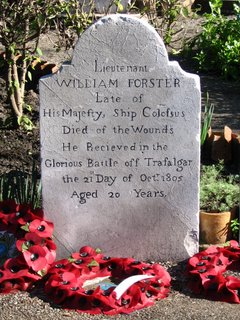 A Devon officer, Gibraltar
A Devon officer, Gibraltar Dedication, Trafalgar Cemetery, Gibraltar
Dedication, Trafalgar Cemetery, Gibraltar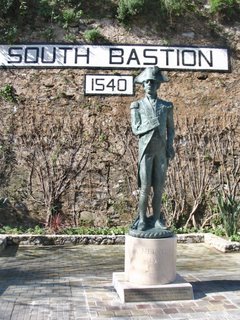 Admiral Lord Nelson, Gibraltar
Admiral Lord Nelson, GibraltarA visit to the botanical gardens above the town, with the cable car to the top of the rock passing overhead, was a must! Here we walked in the bright warm sunshine with glimpses of the warships in the blue bay of Algeciras showing between the green branches of the Aleppo pines and the flowering hibiscus and bougainvillea. Here there were wonderful collections of flowering agaves and cactuses, and best of all, strange dragon trees. These are actually not trees at all but some gigantic version of a lily (we think) that may be several hundreds of years old. Originally thought to come from the Canary Islands a huge forest of them was discovered as recently as the 1990s in Morocco, confirming a long suspected link with the Arab world.
 A Dragon tree, Alemeda, Gibraltar
A Dragon tree, Alemeda, Gibraltar Blazon and keys of the Rock, Alemeda, Gibraltar
Blazon and keys of the Rock, Alemeda, GibraltarDown in the town again we enjoyed some good old British bitter and bought cheese scones and muffins in M&S food hall for a picnic lunch. We then cycled around the Rock, following the bay with its docks, warships and maritime activity, through long dark tunnels cut through the rock, to emerge at the lighthouse of Europa point.
 Main Street, Gibraltar
Main Street, Gibraltar Main Square, Gibraltar
Main Square, Gibraltar Convent Guardroom, Gibraltar
Convent Guardroom, Gibraltar Garrison soldiers with the keys of Gibraltar
Garrison soldiers with the keys of GibraltarEuropa Point is a fascinating place. The rock of Gibraltar was considered by the ancient world to be one of the pillars of Hercules. Another is on the mainland of Africa, visible a mere 14 miles away across the straits. It is a crossroads of so many worlds and cultures. The Mediterranean meets the Atlantic. The continents of Europe and Africa come face to face. The new world of the Spanish Americas meets the old world of Europe, and Christianity meets Islam. It’s impossible not to be moved by such an experience.
 The lighthouse at Europa Point, Gibraltar, with the coast of Africa
The lighthouse at Europa Point, Gibraltar, with the coast of AfricaAt this point stands an impressive mosque with the rock towering above. Here we cycled around the headland a short distance, flowering cactuses covering the lower slopes to our left, while to our right lay the blue waters of the Gibraltar Straits with the dark outline of the Moroccan coast on the horizon. Magic!
 The Rock, the Mosque, Hinge and Bracket at Europa Point, Gibraltar
The Rock, the Mosque, Hinge and Bracket at Europa Point, GibraltarWe returned the long, hilly way back to the town and back across the airport runway. Cars were streaming onto and off the Rock, with delays up to an hour or more in each direction as the Spanish frontier guards checked documents. Our passports were asked for as we cycled up past the waiting cars. It is the first time since leaving Portsmouth nearly six months ago!
Rejoining Modestine on the Spanish side we made our way around the bay, through Algeciras and along the coast towards Tarifa and Cadiz. Tarifa is important as the main migratory route for birds over-wintering in Africa. It is also famed for its constant, warm winds, which has led to enormous wind farms being developed on the clifftops. These have proved a major hazard to smaller birds arriving on the shores of Europe, exhausted from their flight north, only to collide with the blades of the hundreds of white generators.
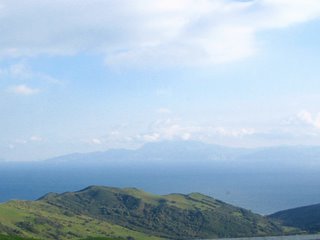 View of Africa from the road to Tarifa
View of Africa from the road to Tarifa Wind farm on the hillsides near Tarifa
Wind farm on the hillsides near TarifaWe have stopped here at Tarifa, at the most southerly campsite in mainland Europe, the sea a few metres from our pitch. As we sat outside watching the sunset we could clearly see the mountains of the African coast, only a dozen miles away.
Sunday 5th February 2006, Tarifa, a different campsite
Because of the constant winds this area is very popular with surfers. Last night’s campsite was right on a beautiful sandy beach and therefore a popular place for water sports enthusiasts. Ian had rather a shock returning from the shower block around midnight to see several full length wetsuits hanging to dry from the trees in the moonlight!
This morning we went down into the town of Tarifa. From here the ferry leaves regularly throughout the day for the 35 minute crossing to Tangiers and the town is completely geared up to cater for young people with dozens of cheap hostals, cafes and restaurants. The main street too, is full of surfing schools and training centres for water sports. Nearly every shop sells or hires wind surfing equipment.
The town has rather a pleasant feel to it and although we overheard someone saying he was amazed at how filthy it was, it didn’t strike us so. Scruffy, dusty and rather too laid-back perhaps. It certainly doesn’t go out of its way to sell itself as a tourist resort. Access to its beautiful beaches is through a galvanised wire fence and there are the remains of wartime bunkers amidst the sand.
The old town is really very nice. Here the streets were cool and largely deserted. Cheerful shouting came from the open doors of bars or courtyards leading off from the narrow streets of whitewashed houses. In the heart of the old town we discovered the Plaza de Santa Maria, a lovely square with palm trees, a fountain, brightly tiled seats overlooking the sea and gardens with shrubs and cactuses. Leading off from the square were narrow alley ways and the surrounding buildings were Moorish in style with horseshoe shaped archways, crenelated rooftops and rounded domes.
 Gateway to the old town, Tarifa
Gateway to the old town, Tarifa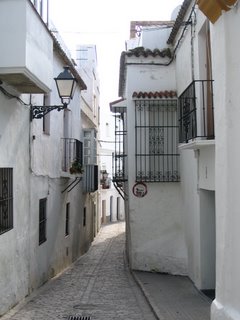 Street in the old town, Tarifa
Street in the old town, Tarifa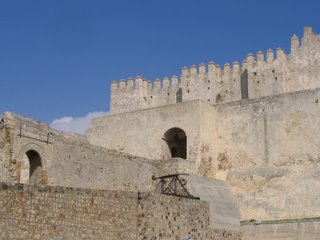 Castillo de Guzmán el Bueno, Tarifa
Castillo de Guzmán el Bueno, Tarifa Sancho V who took Tarifa from the Moors in 1292
Sancho V who took Tarifa from the Moors in 1292 Castillo and houses in the old town, Tarifa
Castillo and houses in the old town, Tarifa Guzmán el Bueno, Christian commander of the Castillo, Tarifa
Guzmán el Bueno, Christian commander of the Castillo, TarifaWhen his son was captured by the Moors and he was given the choice of surrendering the town or his son being killed, he threw his dagger to the enemy for the execution.
 Playa de los Lances, Tarifa
Playa de los Lances, Tarifa Departure of the Tangiers ferry, Tarifa
Departure of the Tangiers ferry, Tarifa Plaza de Santa Maria, Tarifa
Plaza de Santa Maria, TarifaDown near the port we found a little café set back from the street with tables beneath the palm trees. Here we enjoyed paella and cold beers and watched the children of the café owner trying to do their maths homework with their granddad’s help. Just watching teaches us such lot about the language. We hadn’t realised before just how much the Spanish communicate with gestures.
We left Tarifa in the late afternoon after a very relaxed and pleasant Sunday in the sunshine. We enjoyed the town though perhaps would not choose to spend a holiday there. It did rather have the feel of a transit camp between continents. It was good to see families out together enjoying the sunshine though. The Spanish are very family orientated and they adore their children. That’s not surprising though. Most of those we have seen today were quite adorable with huge brown eyes and happy smiles.
We made our way along the coast road towards Cadiz until we found this campsite down a side road towards the beach. It is beautifully set in green fields between the sea and the mountains and we can hear the sound of sheep bells from nearby flocks. It is so very much nicer in this corner of southern Spain. Fortunately the sprawl of the Costa del Sol stops west of Estepona and, so far, speculative tourist development hasn’t reached this area at all.
Monday 6th February 2006, Conil de la Frontera, near Cadiz
This morning we walked down to the beach through peaceful fields and pine woods. The sea here is the Atlantic, a bright green-blue as it rolls in with white capped waves breaking on the huge, empty sandy beach with its grassy sand dunes. The sun was bright and warm and behind the beach the roadside and dunes were full of wild flowers and cactuses.
 The beach near our campsite outside of Tarifa
The beach near our campsite outside of Tarifa Sand dunes encroaching on the pine forest
Sand dunes encroaching on the pine forestWe left the campsite mid-morning and made our way along the coast to Baelo Claudia. Here there are the remains of a large Roman settlement in a wonderful setting right on the beach, with empty green countryside rising to the dark hills behind. Unfortunately when we arrived it was to discover that the site is closed on Mondays. However, it was easy to see much of the site from the beach. It was established in the 2nd century BC as a centre for salting fish and to make the Roman equivalent of HP Sauce - perhaps it should be called SPQR Sauce. Garum was made from the head, blood, entrails and other choice remains of fish, presumably HP Sauce has more agreeable ingredients. Storage vats for this and other produce could be clearly seen and the site had all the attributes of an important city: a forum, theatre, colonnaded streets with houses laid out around courtyards, impressive gateways. It was also a port which, like modern Tarifa, was the gateway to Tangiers. It was given municipal status by Claudius, hence its name, but suffered badly in an earthquake in the 2nd century AD. Although we couldn’t wander around the site, it was worth the
visit anyway for the wonderful view as we descended down to the sea and nearby we
found a pleasant little café where we had lunchtime bowls of lentil soup sitting outside with nothing but the bright beach and sea as our view.
 Forum at Baelo Claudia
Forum at Baelo Claudia Roman theatre at Baelo Claudia
Roman theatre at Baelo Claudia Storage vats at Baelo Claudia
Storage vats at Baelo ClaudiaFrom here we continued along the coast through the Parque Natural de la Breña where we stopped for a walk amongst the cliff top pine forest on our way to Cape Trafalgar.
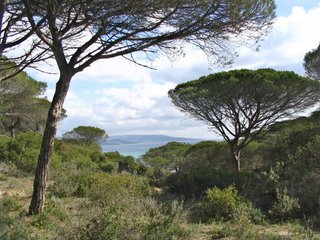 View in the Parque Natural de la Breña
View in the Parque Natural de la BreñaIt was just off Cape Trafalgar, within clear sight of the north African coast, that the famous battle between the British on the one side, and the French and Spanish on the other took place on 21st October 1805. It was during this battle that Lord Nelson was killed, his body eventually being returned to England. It was from here that the British ship the Pickle, sailed immediately with the news of the battle victory and Nelson’s death to Falmouth from where was carried by post-chaise to London by the Devonian Lapenotière. Just before we left Exeter last year, preparations were under way to re-enact, as part of the celebrations to commemorate 200 years since the battle, Lapenotière’s ride. Devon Library Service organised a major exhibition to mark this event in the Exeter Guildhall. So, especially for Roy, who did so much to organise the displays and ensure the success of the exhibition, here are a couple of photos of Cape Trafalgar as we saw it today.
 Lighthouse and remains of watchtower at Cape Trafalgar
Lighthouse and remains of watchtower at Cape Trafalgar Atlantic breakers seen from Cape Trafalgar
Atlantic breakers seen from Cape TrafalgarCape Trafalgar is not the grim forbidding headland jutting out into the Altantic that we had always imagined. It is a low sandstone outcrop topped by a 9th century Moorish watchtower and a lighthouse dating from 1860, and is joined to the coast by sand dunes. The beach today is witness to more peaceful activities. With the wonderful long white breakers rolling in to the shore and the strong winds that permanently affect this coast, wind surfing has become a major activity with dozens of brightly coloured kites towing wet-suited enthusiasts through the waves at great speed. It was really exciting to watch and Jill felt quite envious.
 Wind Surfing at Cape Trafalgar
Wind Surfing at Cape TrafalgarWe decided to camp for the night near Conil de la Frontera and continue to Cadiz tomorrow. We were last in Cadiz in April 2005 when we visited our daughter Kate. When we set off on our travels around Europe we had expected to be meeting up with her there, but circumstances change and she recently moved back to rejoin her friends in Brighton. It will seem odd passing her old flat in Cadiz knowing she is no longer there.
Life really is very unpredictable. Some of you reading this will be familiar with Kate’s travel accounts of India, Cambodia and Laos a couple of years back with her travelling companion Wendy. Tonight we received the tragic news that Wendy was run over and killed on a zebra crossing in Brighton on Friday night. She has been Kate’s very close and loyal friend for many years and we have known her since she was a teenager in Exeter. Wendy was a lively, lovely and happy girl who will be sadly missed by so many people. Tonight we feel a great sorrow as we come to terms with this news.
